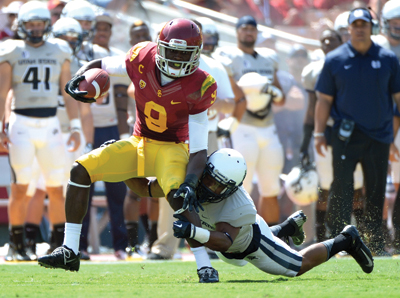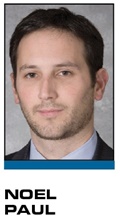Marqise Lee likely lost about $5 million in future earnings because of his drop from a projected top-five pick in the NFL draft to pick No. 39 at the beginning of the second round. The good news for Lee: Insurance may pay the difference.
Lee purchased loss-of-value insurance before his final season at the University of Southern California last year. The coverage insures against the loss of money paid to an athlete whose draft value falls because of an injury. But payment is not a sure thing.
The athlete must show that his fallen draft status resulted from his injury or illness rather than poor conditioning, personal issues or another reason. In fact, there are no reports of insurers having paid a single claim under a similar loss of value policy for athletes.
How Lee’s insurer handles the claim, therefore, and whether Lee receives payment — which could be as much as $5 million after taxes — could be a bellwether of athletes’ ability to recover under such policies in the future. At a time of increasing turmoil regarding college athletes’ rights to insurance and other benefits, collegiate athletic departments, agents and insurers will be keeping close watch over the results.
USC generally encourages its top football players to buy loss-of-value coverage. Prior stars Carson Palmer and Matt Leinert both did so. They did not experience serious injuries in their final year of college, however, like Lee, who suffered a moderate MCL sprain.
 |
|
Marqise Lee’s loss-of-value insurance could pay him up to $5M after his draft position dropped.
Photo by: GETTY IMAGES
|
At the beginning of last year, Lee was projected by many draft analysts to be a top-five pick. According to some observers, however, he was never the same after the injury. His production plummeted and some teams at the NFL combine reportedly expressed concern about his leg. The result: Five wide receivers were picked before him, until the Jacksonville Jaguars selected him in the second round.
Depending on the specific terms of his policy, Lee appears to have a strong claim for coverage. But he likely will have the burden of showing that his draft status fell because of his injury. The insurer might argue that Lee’s value fell for other reasons. Among them, the departure last year of other top-performing teammates, such as quarterback Matt Barkley.
Morgan Breslin, Lee’s former teammate at USC, might have an easier time proving his claim. Breslin also purchased loss-of-value insurance last year and suffered a serious hip injury in November, which caused him to miss 75 percent of the Trojans’ season. Last summer, he was projected by some as a first-round pick, but he went undrafted and signed as a free agent with the San Francisco 49ers. Breslin reportedly could receive as much as $1 million in coverage.
The benefits of loss-of-value coverage are clear and other highly touted players are signing up. University of Oregon juniors Marcus Mariota, quarterback, and Arik Armstead, defensive lineman, already have purchased the coverage for next season.
The consequences of failing to buy the coverage can be severe. Barkley, Lee’s former quarterback, did not buy the coverage for his senior year in 2012.
According to Hanleigh Insurance, one of the few insurers that offers the coverage, Barkley likely would have been the fourth pick in the 2012 draft and received approximately $20 million in guaranteed money. Barkley chose to come back for his senior year, however, and injured his throwing shoulder near the end of the season. In the 2013 draft, Barkley was not picked until the end of the third round. Based on Hanleigh’s estimate of Barkley’s 2012 draft status, Barkley might have received a maximum payout had he obtained the coverage.
Loss-of-value coverage is only one component of insurance for college athletes. The most common coverage for top athletes insures against permanent disability. Offered through the NCAA, the insurance provides a lump-sum payment — up to $5 million — for a qualifying athlete who is unable to play their professional sport because of an injury or sickness that occurs during the policy period. The more money the athlete is likely to earn, the more coverage will be available to them. The coverage is even relatively affordable. The NCAA’s chosen lender offers a low-interest loan to cover the premiums.
But there are complications with the coverage. First, it is not available to all student athletes. Only those with the potential of being selected in the first three rounds of the NFL draft or NHL draft, or the first round of the men’s or women’s basketball drafts or Major League Baseball draft, are able to obtain the coverage. An athlete’s potential for high selection is determined by scouts hired by the insurers. The vast majority of athletes who go on to play professional sports, therefore, have to look to the private market for insurance.
As with loss-of-value coverage, a severe injury will not necessarily trigger coverage. Rather, according to the NCAA, an athlete must show a “disability,” which means the athlete “is unable to engage in sporting activity at the professional level” and the disability prevents the athlete from entering into “any employment contract with any professional team as a professional athlete in his or her sporting activity.”
This determination is made by a physician one year after the athlete’s injury. Given advances in medical treatment of athletic injuries, with treatment of anterior cruciate ligament tears, for example, becoming routine, severe injuries no longer pose the same risk of ending a player’s career that they once did. One example: the quick comebacks of Adrian Peterson and Robert Griffin III from ACL tears.
The handling of Lee’s claim likely will reverberate through collegiate and professional sports. If Lee receives coverage, more top athletes could pursue coverage. If his claim is denied, it could squelch demand and add to the growing chorus of voices seeking more benefits for college athletes.
Noel Paul (npaul@reedsmith.com) is a lawyer in the Insurance Recovery Group at Reed Smith.





